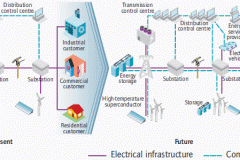 For close to 10,000 years, science and technology have been at the heart of economic growth and social prosperity. From the agricultural revolution to the information revolution, advances in society have been underpinned by new discoveries and their innovative use in new products and processes.
For close to 10,000 years, science and technology have been at the heart of economic growth and social prosperity. From the agricultural revolution to the information revolution, advances in society have been underpinned by new discoveries and their innovative use in new products and processes.
Modern society was enabled by the invention of agriculture, freeing people from a hunter-gatherer existence and allowing the development of stable communities that supported further social and technological innovation.
The invention of the Spinning Jenny 250 years ago vastly increased the speed with which cotton could be turned into yarn, revolutionizing the textile industry and helping usher in the industrial revolution. The discovery of penicillin in the early 1900s allowed previously fatal infections to be treated, opening the door to modern surgical procedures.
In the mid-20th century, the invention and subsequent development of the transistor initiated a technology revolution that is still driving economic and social growth.
More recently, innovations in global communication, social networking and information processing have begun to empower global communities in ways unimaginable a few years ago. Yet the continued effectiveness of science and technology as engines of economic and social growth is not guaranteed.
The global economic and social landscape is evolving rapidly and, as it does, the rules governing how we use science and technology are changing. A growing global population coupled with a widespread desire for a first-world quality of life is placing unprecedented demands on resources around the world.
Humanity’s actions are becoming uniquely intertwined in environmental reactions, redefining our relationship with the planet on which we live and depend. Modern communications are making a mockery of geographical and institutional boundaries that have endured for hundreds and even thousands of years.
This emerging landscape places new demands on technology innovation; but it also demands radical changes in how technology innovation is nurtured and implemented if it is to underpin a sustainable future.

Recent attempts to introduce genetically modified foods into commerce in Europe provide a sobering lesson in how easy it is to mishandle technology innovation. Despite little evidence to the contrary, apparent concerns over health and environmental impacts severely retarded the implementation of a technology that could improve millions of lives.
Yet these concerns were grounded in part in a backlash against corporate control that cut consumers out of the decision-making process. Through a socially savvy media, people and governments were galvanized to say no to “frankenfoods” – not because of the science and technology per se, but because of the way they were handled. Missteps over the development of genetically modified foods are a prominent case among many where the trajectory of a technology has been dictated more by social concerns than by scientific evidence. It is increasingly clear that top-down decision-making is not sufficient on its own to ensure the successful development of socially and economically relevant technologies.
With modern peer-to-peer global communications, virtual groups can be informed about, motivated by and empowered to take action on emerging issues before institutional decision-makers are even aware there is an issue to respond to. We now live in a world where an incident in China or the Middle East can influence attitudes and actions in regions as distant as Europe and the Americas in a matter of minutes through media like YouTube and Twitter.
At the same time, technology innovation is no longer dominated by a top-down approach. We are in the midst of a shift from innovation occurring as a result of a directed programme at large institutions like Bell Labs, Bayer or IBM to a world where a college student can create Facebook, Do-It-Yourself biotechnology has a growing following,1 and work that used to require a lab full of people and equipment can now be done on a laptop.
With this shift, it is easier for technologies to be deployed before most governments are aware of their potential. The constant war against synthetic drugs and legal highs is a case in point: as soon as a government legislates against one substance, a chemist can move a hydrogen atom and create a new one that slips through the oversight net. As technologies like nanotechnology, computational chemistry and synthetic biology continue to mature, top-down oversight will become increasingly difficult to implement. Ensuring that technology innovation serves the emerging challenges facing global society will depend on far more than understanding evolving social dynamics. Under the triple drivers of globalization, unsustainable resource demands and increasing environmental impacts, a full recalibration of technology’s role in addressing global economic, political and social challenges is needed.
Providing people with access to healthy food and clean water; managing climate change and its impacts; treating disease; generating and using energy wisely; working with diminishing natural resources; coping with pollution – over the next 50 years, global challenges in these and similar areas will reach unprecedented levels. Without rapid and targeted advances in science and technology, humanity will be unable to face them without paying an unacceptable price. We need the tools that science and technology provide to build a sustainable future.
Many of these tools are waiting in the wings. Emerging areas such as nanotechnology, synthetic biology, information technology, robotics, neuroscience and others are paving the way for socially and economically important technology innovations. Yet there is a gaping chasm between the knowledge being generated and the understanding of how to use it most effectively. This chasm is widened by the disparity between the economies that are predominantly driving technology innovation and those that are most in need of what it can deliver. As new technologies emerge, it is clear that we can no longer rely on 20th century policies to deliver 21st century solutions. Neither can we assume that emerging technologies – which often take decades to mature – will provide just-in-time solutions to just-identified problems. Rather, we need to rethink how society can continue to reap the benefits of technology innovation without suffering the consequences of missed opportunities and mishandled interventions.
Past policies have relied on upstream investment in exploratory science to deliver downstream technologies. It is a model that has worked well in the past, but is looking increasingly flimsy in today’s interconnected world. More significantly, it is a model that absolves decision-makers of taking a handson approach to science and technology – it reinforces the attitude that technology innovation is somebody else’s business, and the myth that technology “just happens”.
But for technology innovation to be effective in today’s world, decision-makers at all levels – from policymakers to consumers – need a firmer grasp of how science and technology work. They need the knowledge, understanding and tools to foster timely and relevant technology innovation, and to most effectively exploit this innovation. In effect, as conventional top-down approaches to technology innovation become increasingly ineffective, technology innovation needs to become everybody’s business.











Thanks